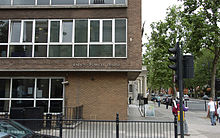Construction
| From an address by Elizabeth II [4] |
| Baden-Powell himself has gone, but his Movement remains and grows—a memorial more enduring than stone or steel. It is fitting, however, that here in England, where he started it, there should be a house bearing his name and serving the needs of the Movement, expressing our gratitude in a practical way. |
Acting on a 1942 initiative by Chief Scout Lord Somers, a formal Baden-Powell House Committee was established by The Scout Association in 1953 under the direction of Sir Harold Gillett, later Lord Mayor of London. The committee's directive was to build a hostel to provide Scouts a place to stay at reasonable cost while visiting London. For this purpose, in 1956 the committee purchased a bombed-out property at the intersection of Cromwell Road and Queen's Gate at a cost of £39,000. [4] [5]
The Scout Movement raised the major part of the funding of £400,000 for building and furnishing the building between 1957 and 1959. Scouts throughout the country collected 'ship' halfpennies, and this raised the bulk of the money for the building. [5] Money was also raised through public appeals supported by publication in Scout Movement magazines, a collection of donations in 15,000 brick-shaped boxes, and 5,000 appeal letters signed personally by then Chief Scout Lord Rowallan. [4] Scouts representing every county were present at the opening.
In a celebration on 17 October 1959 the foundation stone was laid by the World Chief Guide (Olave Baden-Powell), in the presence of Lord Mayor Sir Harold Gillett, the new Chief Scout Sir Charles Maclean, and 400 other guests. A casket was buried under the foundation stone which held 1959 Scout mementoes, stamps, coins, photographs, etc., and a programme of the ceremony. [4] [5]
Use by the Scout Association
With 142 Queen's Scouts as Guard of Honour, and live broadcast by the BBC (commentator Richard Dimbleby), Baden-Powell House was opened on 12 July 1961 by Queen Elizabeth II. [6] Afterwards, she toured the house with the Chief Scout and the president of The Scout Association, her uncle Prince Henry, Duke of Gloucester. A black marble panel with gold lettering was put on the balcony in the hall to commemorate the event. [4] [5]
From 1974 to 2001, Baden-Powell House was the headquarters of The Scout Association, replacing their previous location in Buckingham Palace Road for which a dedicated office extension to the house was opened by the Queen in November 1976. [7] [8] As the association had expanded, the staff were split between Baden-Powell House and Gilwell Park in the historic White House. [8] In 1987 elements of the building were adapted as an events and conference space, expanding the appeal of the building more broadly. In 1993, the Scout Association took the decision to relocate their headquarters and all of their staff to a new purpose-built building at Gilwell Park housing all the association's staff. [8] The decision was in part led by the deteriorating condition of the historic White House at Gilwell Park with the three phase project concluding in April 2001 when the headquarters formally moved to Gilwell House. [8] As part of this development, the adjoining office block was sold to raise funds for the new construction. [9] As the owner of Baden-Powell House, The Scout Association received at this time a net income out of the revenues of approximately £1.5 million. [10] [11] [12] [13]
Thirty-five years after its opening, Baden-Powell House was refurbished in a six-month £2 million programme, providing all modern amenities such as private facilities for all rooms, double glazing, and air conditioning, as well as enhancing conference facilities for large and small events. Upon completion of the programme, the house was opened by the president of The Scout Association, Prince Edward, Duke of Kent on 5 June 1997. [14] [15] A museum to the life of B.P., "The Baden-Powell Story", [16] was housed at the site. [17]
Since its inception, Baden-Powell House provided a hostel for people visiting London, [18] and since 2001 this became the main focus of the building. In the period 2004–2006 the hostel participated in the Youth Hostel Association, after which the Scout Association entered into an agreement with German company Meininger Hotels with Scout members from the UK and abroad being able to stay at a reduced rate. It remained owned by the Scout Association, and advertised alongside the Gilwell Park Conference Centre and the Scout Activity Centres. At its peak, it saw on average 30,000 people spending the night and 100,000 meals served in the restaurant. [10]




